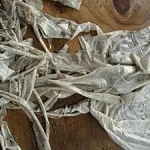BoM’s Weather Balloons SRP
Source Reduction Plan (SRP) Overview
Name of SRP
Partners Delivering the SRP
- Tangaroa Blue Foundation was the first to calculate the impact of weather balloons on the Great Barrier Reef World Heritage Area. The findings were part of a collaborative project with James Cook University, published in the international journal Marine Pollution Bulletin.
Location
Great Barrier Reef, Queensland
Photo 1
Evidence of the issue

Photo 2
Evidence of SRP resources
Photo 3
Evidence of positive outcomes
Overall Goals & Background
Targeted Debris
BoM Weather Balloons
Weather balloons provide vital observations used by the Bureau of Meteorology in forecasts and warnings to protect life and property in Australia. They launch approximately 30,000 balloons a year. Each balloon release consists of a large balloon, an approximately 1m x 1m x 1m polystyrene target with a silver lining, and at night, a torch with AA batteries. These helium-filled balloons rise to high altitudes and the silver lining allows the radar to lock and track them. Once the balloon reaches a certain height it bursts and all the components fall back to earth, often ending up in the ocean.
Why is the SRP needed?
In 2011, Tangaroa Blue identified that polystyrene target components and instruments used to make weather balloons were regularly found during beach clean-ups, particularly in QLD, and started communicating with the Australian Bureau of Meteorology (BoM) about this issue.
“With both the Federal and State Department of Environment prioritising protection of the Great Barrier Reef, it is shocking to find that another Federal Government agency – the Bureau of Meteorology is releasing pollution both into this World Heritage Area and other sites around the country on a daily basis” said Heidi Tait, Managing Director, Tangaroa Blue Foundation.
Logistics
Timeline and Project Goals
3 years
2011 – 2014 with ongoing room for further sustainability improvements
Measuring Success
On January 15th 2014, Tangaroa Blue Foundation received a response letter from the Australian Bureau of Meteorology (BoM) updating us on their plans to reduce the impact of weather balloons and their components on the environment. In the letter, BoM stated that they are committed to minimising any negative environmental impacts arising from their operations through the reduction of the number of balloon releases; and using sustainable materials where possible.
We are pleased to announce that the BoM has now discontinued releasing weather balloons from several locations including Canberra, Carnarvon, Ceduna, East Sale, Eucla, Launceston, Mildura, and Tennant Creek. During the next two years, subject to operational requirements, they also plan to discontinue releasing weather balloons from Cairns, Coffs Harbour, Halls Creek, Longreach, and Mackay.
In late 2014, the Bureau replaced the old polystyrene targets with targets made of cardboard lined with a thin layer of foil. These cardboard targets are now used across the country.
Bureau of Meteorology:
“As an agency that conducts and assists research that supports environmental sustainability for the wider community, the Bureau is committed to demonstrating environmental stewardship. We actively work to continually improve our environmental performance and accountability, including minimising any adverse impacts associated with our operations. Although complementary technologies such as satellites and wind profilers are increasingly used by the Bureau, weather balloons remain a critical component of our observation network and will continue to play an important role during the next decade and beyond.”
Data Collection & Reporting

The graph shows data collected on the weather balloon targets and their components during our Cape Kimberley monitoring site in Far North Queensland, where volunteers clean and collect data every three months.
This successful source reduction plan shows the importance of citizen science data, and how it can be used to push for changes in communities, government, and industry – and improve the long-term health of our environment.
In 2014, Tangaroa Blue worked with James Cook University to publish a scientific paper on “An assessment of weather balloons and associated impacts on the marine environment – An example for the Great Barrier Reef, Australia”
Results and Reflections
Positive Outcomes
Data submitted to the Australian Marine Debris Database indicates this material change has resulted in a significant decrease in weather balloon target components found along the Queensland coastline.
The Bureau of Meteorology has discontinued the use of weather balloons at certain sites, stopped using polystyrene components in production, and committed to improving sustainability.
Funding
Challenges & Improvements
Future Opportunities
The Bureau of Meteorology is still using weather balloons across their monitoring sites nationally and should be looking for more sustainable alternatives where possible – targeting high debris sites as a priority.






